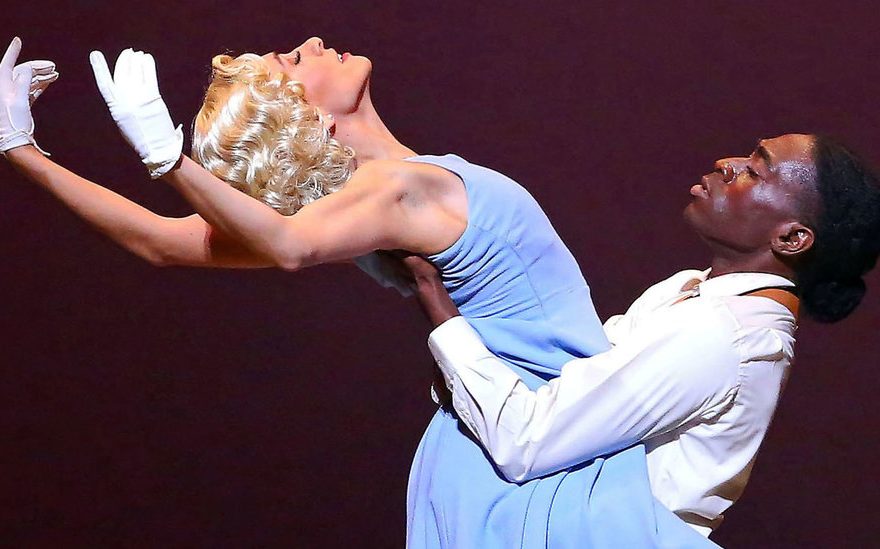No one knows exactly what happened in 1921 when a young black man stepped into an elevator operated by a white woman in the Greenwood district of Tulsa, Okla., but the aftermath was horrific. The man was arrested, and a white mob descended on the area, an affluent black enclave, and destroyed it. Hundreds were killed, injured or left homeless by the destruction.
The veteran choreographer Donald Byrd addresses the massacre in “Greenwood,” which premiered on Friday by Alvin Ailey American Dance Theater at City Center. A harrowing telling of it also opens the HBO series “Watchmen,” which brings it to urgent cinematic life.
Through its unspoken language, choreography can offer a different, sometimes more resonant imagining of space and time. “Greenwood,” though, set to music by the Israeli violist and composer Emmanuel Witzthum, feels more like a montage of images embellished with bursts of movement than a transformational reframing of a real event into a dance. Despite certain poignant moments — mostly involving the otherworldly Jacqueline Green — it’s like being led through a story rather than watching it unfold. And that makes for a long 35 minutes.
Layered into the score are field recordings from Alabama, Mississippi and Louisiana, as well as sound effects like footsteps. “Greenwood” begins and ends with figures entering and exiting through an opening at the back of the stage; flooded with hazy smoke and colors, from a fiery red to a more soothing blue, it seems to serve as a portal for memories.
Mr. Byrd uses the “Rashomon” method, showing three different scenarios of what might have happened in that elevator. Each telling, featuring Chalvar Monteiro and Danica Paulos as the man and woman — she wears a blond wig — starts the same way. He walks with robotic formality to the front of the stage, turns and enters the imaginary space of an elevator car. Ms. Paulos stretches out her arms and closes the door. We hear footsteps and the squeak of a gate. Each time it ends with a scream.
The first is brief: Did he touch her accidentally? The second time, they melt into each other’s arms when the door closes. Their secret is an innocent romance. The third time, the situation takes a violent turn as he forces himself on her. As Mr. Byrd suggests, no one knows what happened in that elevator, but his approach and the long-winded dances that follow are more predictable than powerful. Again and again, we see Ms. Paulos’s dazed, Stepford-wife expression and the sight of Mr. Monteiro running in place.
There are also other characters: Two well-dressed couples representing the Greenwood community transform throughout the narrative; their poise crumbles into shakes and jerks — trauma overtakes them. Seven others, shrouded from head to toe in silver, thrash around the stage in swirls of aggression and rage as racist killers. Unfortunately, they look more like metallic beekeepers than members of, say, the Ku Klux Klan. Choices had to be made. This is a company largely made up of dancers of color; you can see how showing their faces would be confusing, but here, the effect is more cartoonish than ominous.
That leaves Ms. Green to keep watch as the scenarios unfold. In a floor-skimming skirt and top with her hair wrapped, she looks like she comes from another time than the others: Is she our conscience, an ancestor keeping watch over the spirits of the community, or both?
For all of her beauty, the statuesque Ms. Green, breaking into solos that emphasize her long lines and angles, is never decorative. Rather, her emotions emanate from a searing source of fortitude and pain. In one moment, she’s as still as marble; in another, she’s electric. Her arms and legs stretch from her torso as if she were trying to tear herself in two. At the core of “Greenwood” is the voice of Ms. Green’s body and its sense of immeasurable grief.
Friday’s program, which also included Ailey’s sumptuous “Night Creature,” set to Duke Ellington, and Robert Battle’s “Ella,” a gimmicky interpretation of Ella Fitzgerald’s scat song “Airmail Special,” ended with one of the most moving performances of “Revelations,” Ailey’s 1960 masterpiece, I’ve seen in ages.
This time, as it does at just a few shows, it featured live music, which emphasized certain qualities, both mournful and celebratory, and above all created a moving canvas for reflection. James Gilmer, who joined the company this year, was a force in the “Sinner Man” section. Big and broad, he’s unafraid to take up space and pulls off a throwback 1970s look that I love.
The veterans had much to offer too, especially Jamar Roberts, dancing with Akua Noni Parker in “Fix Me, Jesus.” His was a slow stunner of a performance in which he drew out every note with a stoic, unaffected patience. But was it even a performance? It didn’t seem like he was dancing for us, and that was the remarkable part: It was in service to the choreography, and it spoke to the way modern dance is a reflection of life, good and bad.
Alvin Ailey American Dance Theater
Through Jan. 5 at City Center, Manhattan; nycitycenter.org
Source: Read Full Article
